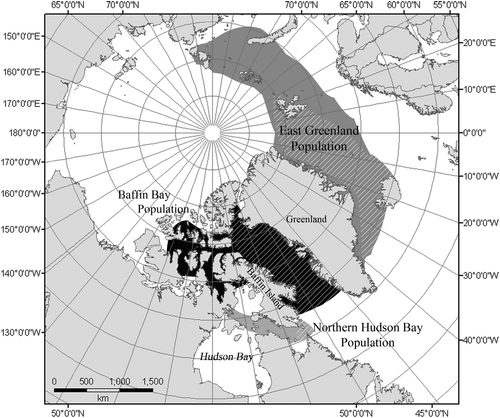FEEDING BEHAVIOR

Narwhals are carnivores with a specific diet, feeding primarily on fish and squid, particularly polar cod, arctic cod, Greenland halibut, and squid of the genus Gonatus. Since they are capable of diving more than 500 meters below sea level their most preferred catch is the Arctic cod. Both the diet and the intensity of feeding vary seasonally. Besides this, Narwhals also have a peculiar craving for cuttlefish, shrimp, and Armhook squid, all of which are found swimming within the deep ocean.
During the summer, narwhals feed very little. They begin to feed more heavily in the autumn during migration and especially during the winter at their deep-water wintering grounds. In Baffin Bay, Greenland halibut dominates their winter diet. Arctic cod, polar cod, and squid are available in deepwater areas where narwhals cannot reach the bottom of the sea. During the spring, as the ice edge retreats, polar and arctic cod become increasingly important in the diet.
Like other creatures in the Monodontidae family, narwhals simply inhale their food whole. Because of the lack of well-developed dentition in the mouth, narwhals use a vacuum-like tactic to suck up their food. They have flexible necks that give them the ability to scan broad areas for prey.
Foraging
Of the narwhal populations in the world, there are three spatially and genetically segregated groups. The East Greenland (EG) population inhabits the eastern shores of Greenland and the Greenland Sea with current estimates of about 6,000 individuals ( Heide‐Jørgensen et al. 2010). The Baffin Bay (BB) population overwinters in the Davis Strait and spends summer in the fiords and inlets of northern Canada and western Greenland and is estimated to be larger than 60,000 individuals (Richard et al. 2010), and the Northern Hudson Bay (NHB) population spends winter in the Hudson Strait and summers in northern Hudson Bay (Richard 1991) and is estimated at 12,500 individuals (Asselin et al. 2012).
According to C. A. Watt, "current knowledge about the narwhal diet comes primarily from stomach content analysis on hunted narwhals from the BB population, with no studies being conducted on the NHB or EG narwhals" (Watt et al., 2013). From the stomach contents, Greenland halibut, Arctic cod, polar cod, and squid (Gonatus fabricii) were identified as the primary prey. Researchers have solely relied on stomach content analysis, although insightful for a first understanding of narwhal diet, this only provides information on what they had for their last meal. For Arctic marine mammals that experience seasonal changes in food availability and diet and have high‐energy requirements, stomach contents can be biased since they only provide information on the most recent meal from a specific foraging area. Thus, this may not be representative of typical feeding events.
Among the three narwhal populations, it is possible that they each have developed a preference for different prey and may be more flexible in their foraging behavior. Narwhal flexibility in preferred prey may help them face changing food web structure and prey distribution that are accompanying climate change. It is possible that, if necessary, narwhals may be able to switch primary prey and monopolize on the increase in capelin abundance, which may mitigate the negative impacts of reduced cod and benthic species.
There also appears to be sexual segregation in the diet for all populations, which may be related to the diving ability of males and females. But given the sexual size dimorphism, male narwhals have been shown via stable isotope analysis to feed more on the benthos than females (Watt et al., 2013), which is indirect proof of males diving deeper than the females. It has also been suggested the supinate swimming behavior of narwhals may be related to foraging. By swimming upside‐down, males can orientate their tusk toward the bottom to guide benthic prey towards their mouth. Spinning is also an integrated part of narwhal swimming behavior but the amount of spinning correlates with foraging behavior.


Figure 1. Approximate summer (solid) and winter range (hashed) for narwhals from the three populations: Baffin Bay (black), East Greenland (dark grey), and Northern Hudson Bay (light grey). https://esajournals.onlinelibrary.wiley.com/doi/full/10.1890/ES13-00137.1
Figure 2. Data on δ13C, δ15N, and mercury in narwhal tusks measured in layers corresponding to the period 1968-2010. The cover of summer sea ice for the same period is also shown. Credit: Aarhus University, Denmark. https://scitechdaily.com/the-narwhals-impressive-unicorn-like-tusk-reveals-its-past-living-conditions/.
Table 1. Live-Capture and Instrumentation of Narwhals; description of individual deployments and datasets. https://www.frontiersin.org/articles/10.3389/fmars.2020.596469/full.
